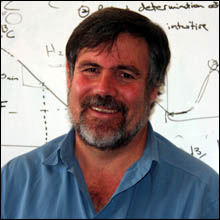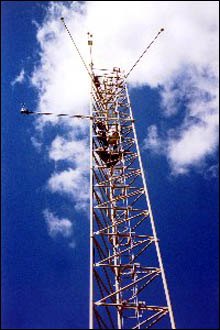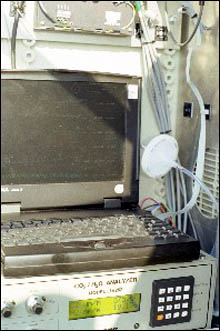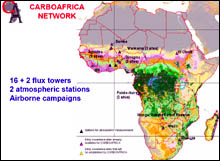Africa - Under-represented and under-researched, yet vital for climate change studies
|
Amid wide-scale reporting on the issue of climate change and global
warming, and the release this year of a series of four
Intergovernmental Panel on Climate Change (IPCC) reports, SAEON eNews
interviewed Dr Bob Scholes of the Council for Scientific and Industrial
Research (CSIR) and a member of the SAEON Technical Steering Committee
to get a clearer picture of the imposing threat. Dr Scholes, a world
renowned expert on Earth observation, has been involved in several
long-term observation and monitoring projects to detect the impact of
climate change in the savanna regions of southern Africa, among other
places in Skukuza where a carbon flux tower has been erected for this
purpose.
SAEON eNews talked to Dr Bob Scholes about the global carbon budget,
his long-term observation projects on climate change involving the
Skukuza flux tower, and the link with SAEON.
"The IPCC reports present irrefutable evidence from around the world that cumulative greenhouse emissions since the industrial revolution have caused and continue to cause global climate change, and will undoubtedly continue to do so for many decades to come," says Dr Scholes. This is expected to lead to further global temperature increases, sea level rises, ocean acidification, the melting of glaciers, extreme weather phenomena and disruptive changes in regional rainfall and weather patterns.
Although there are scientists who still claim that global warming is a hoax, their numbers are diminishing. "The instruments are showing it, the thermometers are showing it, and scientists are nearly unanimous on this," explains Dr Scholes. "We genuinely face a world-threatening problem, and if we don't turn it around in the next 25 years, we're all going to boil in hot water of our own making," he warns.
According to Dr Scholes the build-up of CO2 in the atmosphere is one of the main causes of global warming. It has an enormous inertia associated with it, and to stabilize the atmosphere the emissions have to be more than stabilized; they have to come down by as much as 95%, he says.
Long-term observation scientists seem to think that this is possible, even with existing technology. "It comes down to recognition and internalization of the problem," says Dr Scholes. "People are not going to take action unless they really believe that this is something which is deeply threatening to their wellbeing."
A "commons' problem
The global atmosphere is a so-called "commons" problem, and in cases such as these no one is rewarded for making the first move, says Dr Scholes. From a negotiation point of view it is better to keep a low profile until someone else takes the first steps (and the pain) and then go in for a free ride. What is required in this case is a collective understanding that global warming poses a threat to mankind as a whole so that a regime can be put in place that allows authorities to enforce compliance. Only then will the problem be resolved. But before a compliance regime can be established, common agreement still needs to be reached that global warming is a matter of at least as much importance as fighting terrorism.
The IPCC reports are expected to set the tone for policy making in coming years, including the effort to extend the UN's Kyoto Protocol beyond 2012. Kyoto binds 35 rich nations to cut greenhouse gas emissions, but has been undercut by a 2001 pull-out by the United States, the top emitting nation. US President George Bush says Kyoto would cost US jobs and wrongly excludes developing nations such as China. But with the occurrence of natural disasters such as hurricane Katrina, some US scientists have started to issue warnings that the climate problem can have serious ramifications. "We've seen a significant change in US perceptions over the last six months," says Dr Scholes, "but it hasn't yet percolated through to their signing of the Kyoto agreement."
International treaties such as the UN Convention on Climate Change are in place to control rising levels of carbon dioxide, a problem which has been on the global agenda for the past decade. These treaties seek to keep climate change below "dangerous levels" by defining how much CO2 given nations are allowed to emit. The Kyoto Protocol stipulated that the developing countries, such as South Africa, will not have an upper limit on their emission because they need to be allowed to develop. This set of rules only applies for the first commitment period until 2010. The stipulation will have to be changed in the second commitment period which will start in 2010 so that all countries join in to control this growing problem, says Dr Scholes.
"Given that it has been almost impossible to get the developed countries to comply with a modest emission cap in the first commitment period, it will be difficult to negotiate for the second commitment, but I think it will be done," he predicts, "I think that leading developing countries such as China, India, Brazil and South Africa are highly likely to accept some degree of emission cap in the second commitment period, which will make it possible for countries like America which have lagged behind, to sign up, which is the best case scenario."
Net carbon and energy balance of savanna ecosystems in SA
This delicate balance rests on three pillars - carbon, energy and water balance. All of these have to add up. If they don't, one of them is accumulating somewhere in the system, or the calculations are wrong.
Energy in this sense refers to solar energy which essentially drives ecosystems. By means of photosynthesis the ecosystem turns the energy that comes down from the sun into chemical energy, which provides the driving force for every single aspect in the ecosystem. Solar energy needs to be converted into all those different forms of energy and this is what constitutes the energy balance. A certain amount of energy bounces straight back out in space - a phenomenon known as the albedo. If the albedo changes, the amount of energy that is absorbed in the earth's surface changes and temperatures change accordingly.
Some of the energy which is absorbed gets re-radiated in the long wave. This is the process that triggers the whole global warming phenomenon, because if that long-wave radiation gets reabsorbed into the atmosphere, that which is neither reflected nor re-radiated has to be used up in the ecosystem. The main way in which it is used up is by way of water evaporation. This is what forms the link with the water budget.
"We as scientists are often interested in the water that is not used by the ecosystem, because that is what goes into rivers and into groundwater," says Dr Scholes, "but that is a tiny fraction. Most rainfall is evaporated, and the evaporation is driven by solar radiation." All these aspects have to add up; the water, the energy and the carbon are all linked. They all work together, and by making sure that the numbers add up in each case is how scientists know that their measurements are accurate.
|
Carbon trading and carbon credits
Dr Scholes sees carbon trading as a sensible way to address the issue of emissions. Placing a value on carbon, and allowing it to be traded between those countries that reduce emissions more than they need to, and those that exceed their targets, is an economically efficient way of solving the global problem and one of the few ways that developing countries can actually get some benefit out of climate change.
There is a rapidly growing market for "carbon credits". The way it works is that you get a much bigger emission reduction for a certain amount of money by doing it in areas where the cost of emission control is lower than in places where the cost of emission is higher. If, for example, you are located in Sweden, squeezing out an extra percentage of energy efficiency from a really efficient system is much more expensive than going into a country such as the Congo, where, by replacing an ancient system with a modern system, you can generate a massive increase in efficiency, and in addition it will benefit the local people if new technology is introduced and paid for.
From a climate point of view it is irrelevant where you reduce your emission, Dr Scholes explains. "The atmosphere doesn't mind. It makes absolutely no difference to it whether you reduce an emission in Japan, or whether you reduce an emission in Argentina. We need to do the maximum possible to reduce emissions - we're facing a crunch situation here where all devices need to be harnessed," he says.
There are dissenters who say that such a system could be badly implemented, but, debates Dr Scholes, there are always safeguards that can be put in place to ensure that implementation is done properly. Provided the carbon trading process is properly regulated and audited and does not degenerate into a dumping exercise, it does have considerable merits. It is by far the most efficient way of achieving the maximum reduction in the minimum amount of time that is available at present. "I predict that carbon trading and auditing will evolve into a whole new industry," he says.
For most African countries that do not have large industrial CO2 sources that they can reduce, thereby generating credits for sale, storing carbon in forests and soil is a relatively cheap option. The problem is that those same soils and forests are already mopping up CO2 of their own accord, so how do the customers know that they are in fact getting what they paid for?
Inverse modelling
It is crucial to know what the size of these natural sinks are, what causes them and where they are located.
Africa is a region highly vulnerable to climate change due to ecological and socio-economic factors. However, it is the region least covered by studies on climate change and the flux network for carbon studies is underrepresented on the continent.
Scientists have not yet discovered why Africa, and South Africa in particular is a small sink. "We know that there is a bush encroachment problem in SA which may or may not be related to historical changes in the climate and atmosphere, and we know that this sucks up carbon, so it might be one of the contributing mechanisms," explains Dr Scholes.
In fact, Africa as a whole is a small sink for carbon dioxide. This has come to light through a technique known as inverse modelling, by means of which global distribution of carbon sinks can be calculated in broad latitudinal bands. Very precise measurements of the northern hemisphere to southern hemisphere gradient of atmospheric CO2 measurements are compared to computer simulations of what that gradient should look like for a known distribution of sources of CO2 (mainly in the northern hemisphere) and a speculated distribution of sinks.
But the ability of these techniques to narrow down the sources and sinks to smaller regions, and to decrease the uncertainty associated with the estimates, is limited by the absence of high-quality measurements over land, especially over Africa.
This is where a number of large CSIR projects play a critical role, involving the Ecosystem Processes and Dynamics Research Group of the CSIR's Natural Resources and the Environment division.
Skukuza flux tower
The Skukuza flux tower, a critical tool in these projects, was sponsored by the National Aeronautics and Space Administration (NASA) in 2000 and donated to the CSIR on completion of NASA's Safari 2000 programme. The CSIR's Natural Resources and the Environment division have had a whole series of projects running at the tower, starting with Safari 2000. Their participation in Safari 2000 was sponsored by the Department of Science and Technology.
After that they embarked on a project called Biocomplexity in African savannas, funded by the US NSF that continued operations at the tower from 2002 - 2005. The three-year African Carbon Experiment, which is funded by NASA and the National Oceanics and Atmosphere Administration (NOAA), has now entered its third year, and will ultimately feed into a European Union-funded project known as CarboAfrica. This project is aimed at gaining a better understanding of the land carbon dynamics of Africa as a whole.
Very precise CO2 measurements over land are not easily achieved because the land surface everywhere is very patchy (unlike the ocean). A large nearby source or sink can completely distort measurements. One solution is to take measurements from very tall towers, a kilometre or more in height, but these are very expensive to construct. The CSIR and its collaborators from the USA are working on an innovative technique to combine "flux" measurements (up-and-down exchanges between the land and atmosphere) and concentration measurements, both taken close to the land surface, to estimate the measurements that could come from tall towers. The CSIR-operated flux tower near Skukuza in South Africa's premier game reserve, the Kruger National Park, is crucial to this experiment.
A second approach to the problem is "bottom-up" rather than the "top-down" inverse modelling studies. If, by using a combination of models and satellite observations, we were able to predict what each bit of the African land surface was doing with respect to carbon and other greenhouse gases, we could add all of these up to get the national or all-Africa estimates, which could then be verified against the atmospheric measurements. To do this, we need to understand the processes of photosynthesis and respiration from African ecosystems much better than we currently do. This is the objective of the CarboAfrica project. It aims to increase the flux measurement sites in Africa from the current one or two to about 20 to enable us to quantify, understand and predict the carbon cycle in Sub-Saharan Africa.
The data generated will fine-tune the models used for predicting carbon exchange from land ecosystems to allow them to work much more accurately in Africa. Apart from narrowing the knowledge gap on the global carbon cycle, there are spin-off benefits in being able to predict forest growth and rangeland productivity for purposes of sustainable development.
And given that Africa is a source of CO2 due to factors such as deforestation and industrial emissions, there must be quite a large sink somewhere to counterbalance these emissions. Observation scientists such as Dr Scholes have a fair amount of confidence in inversion techniques at this scale and can say with a fair amount of confidence that Africa isn't a big source. It's either a small sink or approximately neutral.
"We do know what constitutes large sinks,' says Dr Scholes, "we know that, overall, the oceans of the world are sucking up somewhere in the region of 2 petagrams and ecosystems on land are sucking up about 1,3 petagrams - those are enormous sinks."
The land sink is expected to saturate this century and it looks as if the seas will saturate as well in a slightly longer time frame, but there are negative consequences to the seas continuing to suck up carbon dioxide. In recent years it has been discovered that the acidity of the oceans has been increasing. This hinders the metabolism of microscopic marine organisms that build their shells out of calcium carbonate - the very process that enables the oceans to keep sucking up CO2.
The Skukuza tower is just one of a series of towers all over Africa quantifying ecosystems that have been poorly quantified up to now. There have been significant numbers of flux towers operating in biomes such as arboreal forests and grasslands, but almost none in savannas, says Dr Scholes. Although there have been several in tropical rainforests there have been none in Africa. The concentration has always been in areas surrounding the forests.
With CarboAfrica the key measurements are taking place in semi-arid, arid and moist savannas. These are measured not only in their undisturbed state - which constitutes a useful reference - but half of the new towers that Dr Scholes and his team will be erecting in the South African part of the experiment will be in highly transformed situations. "We are trying to understand what happens when you change these savannas into settlements, agricultural or rangeland areas," he explains.
The overarching goal of CarboAfrica is to set up the first part of a flux monitoring network in Africa to quantify, understand and predict - by means of a multi-disciplinary, integrated approach - the greenhouse gas budget of Sub-Saharan Africa and its associated spatial and temporal variability. The current land use change in Sub-Saharan Africa will be assessed and the potential for carbon sequestration evaluated in the context of the Kyoto Protocol.
Collaboration with SAEON
"Because I was involved with the design of SAEON and have been involved in environmental observation design for over 10 years, I know what is required for a network such as SAEON," says Dr Scholes. "Our work is completely consistent with SAEON's operations. If you look into systems around the world that measure ecosystem behaviour, at the top end they always have systems such as our flux tower operations."
In locations that are intensively monitored on a continuous basis, observation scientists usually use highly sophisticated in situ techniques plus remote sensing. "This is the package we are operating at Skukuza," he says, "and the data will be made available to SAEON. It is completely consistent with the SAEON mandate for data management, to the extent that SAEON could continue operating that site if it corresponds with their planning, or measurements of this nature could be conducted at any other site in the savannah biome."
The flux towers for which Dr Scholes and his team are responsible are all located in the Ndlovu Node's territory. They are all working in association with the Skukuza tower.
Dr Scholes does not rule out the possibility that flux towers may be erected in areas covered by other SAEON nodes. "What is important is that each SAEON node defines its key questions from a science perspective as well as from a user perspective; only then will it be able to design the right tools to use," he says. "Although I cannot speak for any of the nodes, I can imagine the circumstance where certain of the nodes may want to go with flux technology of some kind."
Monitoring the savannas of the world
There is hardly a region in the world where there aren't scientists looking at the issue of global warming, yet the savannas are still vastly underrepresented. Savannas make up a 6th of the world's surface. It is the biggest single land ecosystem, and it has the biggest single net primary productivity because it has a big area and a relatively high production. Other areas which are big, such as deserts, have little or no production, whereas one gets areas with a high production, like the tropical rainforests, that are significantly smaller.
There are a handful of long-term monitoring sites in the savannas where a handful of scientists are working compared with the numerous sites in forested ecosystems and the hundreds of scientists working there. "That is clearly out of kilter," says Dr Scholes, "and we are working to redress that."
As the SAEON Ndlovu Node will be involved in observation monitoring and research in the savanna biome of South Africa, it will undoubtedly play a key role in adding valuable data and knowledge to the pool of global knowledge on savanna ecosystems.














